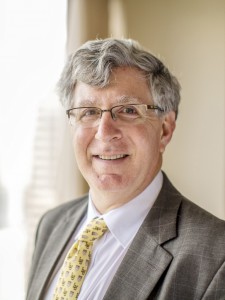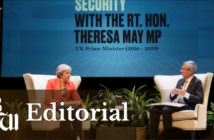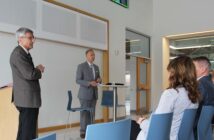Sitting on John D. Simon’s night stand is an old, worn copy of “Lehigh University: A History of Education in Engineering, Business and the Human Condition.”
Simon found the book online and ordered it from a rare bookstore in Bethlehem. The newly announced 14th Lehigh president decided he’d better learn a lot more about Lehigh than he currently knows.
“I think it’s really important for people in this type of leadership role to understand…the institutional culture because you have to work within the institutional culture,” he told The Brown and White. “But I think it’s important to understand what gave rise to the institutional culture.”
The book, Simon said, covers Lehigh history up until 1990. The rest he hopes he can hear about in person from the community members who lived it.
Simon, currently the executive vice president and provost at the University of Virginia, was announced as Lehigh’s new president Friday by Board of Trustees Chair Brad Scheler. In statements released by the university, Scheler hailed Simon as the “right choice,” and Interim President Kevin Clayton praised him as the “unique individual” who could lead Lehigh to greater success.
After an eight-month search process during which a committee of trustees, administration, faculty and students reviewed more than 250 candidates, it seems as though Lehigh has found the ideal candidate to fit its needs.
Simon is confident that Lehigh is the perfect fit for him, as well. Throughout the search process, he said he was astounded by the welcoming atmosphere Lehigh created for him. In fact, Simon recalls his first meeting with the search committee in New York City and the first words Clayton said to him before his interview: “Welcome to Lehigh.”
“Just the passion that I have seen, whether it’s the alums, the faculty that I have met, the students I’ve met on a tour…there’s just this incredible love of the institution and what the institution tries to do,” he said.
For Simon, this passion resonates in every member of the Board of Trustees that he’s met, as well, and it’s an experience he’s truly never encountered before.
“They love the place, and they really want to see it just be great and be a fantastic experience for students and faculty and staff,” he said. “It (the university) has a great tone.”
Bottom-up organizer
The role of a university president is vast and all-encompassing. He or she must consider the needs of different campus groups, working to appease alumni, faculty, staff, parents and students as well as working to address concerns on a local and national scale. In short, he or she must please a lot of different constituency groups who are often very strong-willed and self-interested.
UVA law professor George Cohen is convinced Simon is up to the challenge, however. Cohen, who has worked with Simon as the chair of UVA’s Faculty Senate, said that Simon is a “big believer in faculty governance,” always taking care to consider faculty opinion when faced with challenging, important decisions. He recalls one of the first discussions he had with Simon during which he and other Faculty Senate members were seeking Simon’s approval to do something.
“He said to us, ‘You have more power than you think you do,'” Cohen said. He remembered Simon adding that they didn’t need to ask permission to take a certain action because he and the Senate were collaborators. Cohen emphasized that this discussion is representative of how Simon deals with every university group.
“You have a lot of different constituencies,” Cohen said. “You have alumni, you have faculty, you have staff, you have other administrators, and trying to get them all to be coordinated in pursuit of the university’s goals and visions and strategic plans and the like is not an easy thing to do. I think he has a great ability to do that, to bring people together to work toward common goals.”
To pick a common goal, though, is challenging for a president. There are so many issues a president must deal with that he or she cannot often pick just one focus.
An issue Lehigh Provost Pat Farrell hopes Simon will prioritize is campus climate.
“I’d love it if he would help us continue the momentum we think we’ve built around campus climate, continuing to improve campus climate,” Farrell said. “Its a work in progress. It will be for a long time, but as much support and engagement from John as possible would be great.”
Simon is no stranger to campus culture issues. Prior to his service at UVA, he worked as the vice provost for academic affairs at Duke University for six years. During this time, Simon headed a major campus culture initiative, spending seven months meeting with various groups on campus to break down the issues surrounding campus climate and diversity inclusion.
The initiative followed the 2006 Duke lacrosse scandal in which three players were charged with first-degree sexual assault, kidnapping and rape. The players were ultimately found innocent of the charges in an April 2007 North Carolina court decision, but the case raised concerns about the way Duke students interacted with each other and what kind of culture the students and administration created on campus.
Simon was tasked with figuring out “how to have conversations with the university that could lead to a better understanding of the issues that were really at play in campus culture,” he said. He met with somewhere between 40 and 50 student groups, from fraternities and sororities to athletic teams to the Black Student Union to freshman halls. The goal, he explained, was to have real discussions about student culture.
“I learned an amazing amount,” he said. “It was a very unique opportunity because it should have never come through the provost’s office, so it was an opportunity to sit down with students and have really candid conversation about a whole range of issues.”
At the end, Simon wrote a report about four to five pages long that he published in The Chronicle, Duke’s student newspaper. In the report, he summarized what he had heard from students, categorized the information and offered recommendations for action the university could take. Meant to be an interim report, Simon hoped it would serve as a platform for continuing conversation before final decisions were made.
“My own view is if you try and impose solutions top-down, they generally don’t work,” he said. Instead, Simon emphasized to provoke real change, it is necessary to have “real discussion and a real willingness to engage with incredibly difficult issues with the understanding that you’re not the only one dealing with the issues you’re dealing with at Lehigh either.”
Simon said he made the decision to publish the report in the student newspaper because he wanted to put it in the hands of students and faculty. He wanted everyone to read it and to contact him with comments or concerns, something he thought would be scarce if he PDF’ed the report and put it on the provost’s website.
For Simon, the more voices in a situation like this, and the more conversation, the better.
“What I always worry about with these types of things is: Have you heard a local minority or have you really heard the issues?” he said. “It’s not that I don’t believe what I hear, but a little due diligence can go a long way in making sure you’re getting the founding of the whole community.”
The initiative Simon and his office led culminated in the creation of a new position, the dean of undergraduate education, and when hiring into this position, he said they sought out an individual that would reflect the changes that needed to be made on campus.
Simon’s office produced a final report on the issues, as well, but he said he’s not sure if anyone read it — and that was the best thing about it.
“When we created the dean of undergraduate education and did a baton pass with some real plans on how to move forward with some of these issues, I think that’s what people cared about,” he said. “In partnership with faculty and students, we’re going to try to move forward on these issues. So there was much less interest in what was written down on paper in some sort of formal, final report.”
Campus culture is not the only issue where it is vital to have open, candid conversations, however, Simon said. He indicated that at UVA, student groups and the student council are beginning to have serious conversations about campus safety.
These conversations arose after 18-year-old sophomore Hannah Graham disappeared from an area just off campus on Sept. 13. The ongoing search for Graham has prompted students to make campus safety an utmost priority, and Simon said he has spent a lot of his time recently talking about the issue.
Simon said he is not completely up to speed with how Lehigh students view their campus and the Bethlehem area in terms of safety, but he intends to unpack the issue with students before he takes office in July. Campus safety, however, is at the top of his priority list.
“If people are going to get a maximum experience out of being at Lehigh for four years, they’ve got to feel it’s a safe place to be,” he said.
Simon highlighted the importance of forging partnerships with local officials to create a safe community for students on campus as well as Bethlehem residents.
“At least what we’re finding in Charlottesville, and I think the same will be true for Lehigh, I think real progress in that (campus safety) is likely going to result in true partnership between South Bethlehem and Lehigh,” he said. “As I suspect it’s not limited to the campus itself.”
With any issue, Simon stressed the importance of evoking lasting change that will surpass the current student body and last for future generations. Only sustained change will really make a difference, he said.
“I saw this with Duke lacrosse,” he said. “Four years later people were talking about it, but they weren’t there during it, and so their issues changed. So the question is: Did you really learn from it that you changed things on your campus so that it’s safer for the generations to come?”
‘Academic at heart’
Simon carries the confidence of a man fully prepared to take on the challenges of a university president. However, he did not always have the desire to take on the role.
A couple years ago, Simon said he never would have wanted to be a university president, he recalled. When he looked at the universities he had worked at, it didn’t seem like the right fit for him because he didn’t like not being able to know the faculty and students well and didn’t want to be constantly pulled in different directions.
Lehigh’s smaller size, however, a university of approximately 5,000 undergraduate and 2,000 graduate students, convinced him to embrace the role.
“In both my jobs at Duke and Virginia, the schools are so large and so complex that trying to get your arms wrapped around it or your body wrapped around an issue is just really challenging,” he said. “I mean, I love that complexity as a provost. But I’m really looking forward to a school where I actually think you can get your arms around it and be a part of it.”
For Simon, Lehigh is the perfect size, allowing him the freedom to carry out his presidential duties, such as connecting with alums and engaging in philanthropy, as well as spend time getting to know the institution.
Alexandra Stephanou, ’15, a student representative on the Presidential Search Committee, has no doubt Simon is eager to engage with the Lehigh community. She was captivated by his energy during the search process and is excited for other Lehigh students to get to know him.
“I think he’s thrilled to get to know the students,” she said. “He was excited to get to know the two students on the search committee when we were interviewing him, so I think once he gets on a campus of 5,000 he’s not going to be able to control himself. He’s just going to want to get to know everyone.”
Simon echoed Stephanou’s words, saying he is looking forward to making connections on campus.
“I see the size of the institution enabling you to feel that you’re actually part of the community on the campus,” he said. “And that’s really important to me. I’m actually an academic at heart, and I wouldn’t want to be detached from that.”
Simon plans to be on campus Monday, Oct. 27. He said he is clearing his schedule to spend a few days at the university. After this first visit, he intends to visit monthly for two- to three-day trips until he moves in full time in July.
Over the next eight months, Simon hopes to spend quality time with Lehigh’s senior leaders, student groups and faculty. He emphasized that he will do everything possible to be on campus for every important event that Clayton or others feel he should be present for.
“I still have a job to do, but I can tell you where my mind is,” he said, laughing. “As someone told me, ‘You’re the 14th president as soon as we announce it.’”






Comment policy
Comments posted to The Brown and White website are reviewed by a moderator before being approved. Incendiary speech or harassing language, including comments targeted at individuals, may be deemed unacceptable and not published. Spam and other soliciting will also be declined.
The Brown and White also reserves the right to not publish entirely anonymous comments.